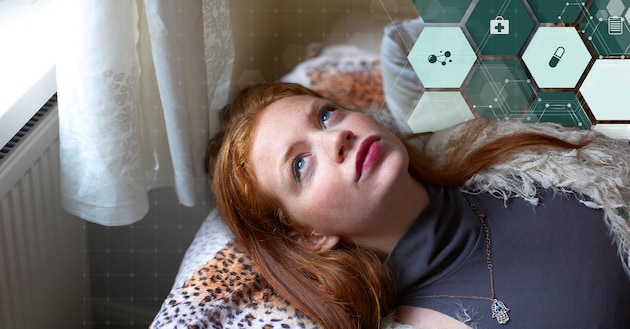Depression is one of the most common mental illnesses and is widespread. In this overview you can read how you can recognize depression, what causes and risk factors there are and how those affected can find healing.
“When depression has a hold on you, life becomes water. The air around you becomes water, crippling you with its weight, and even the simplest tasks suddenly become difficult. You feel sluggish, mentally and physically, and nothing can free you from it.” This is how author Jamie Flexman describes the illness of depression.
It becomes clear here that depression is not simply a temporary state of mind. Phases of depression and sluggishness, low moods – most people experience these at least once in their lives. Depression in the medical sense goes far beyond occasional depression:
“From a medical point of view, depression is a serious illness that profoundly influences the thoughts, feelings and actions of those affected, is associated with disorders of brain and other bodily functions and causes considerable suffering,” writes the German Depression Aid Foundation.
Therefore, depression, like any other illness, requires treatment because those affected can rarely free themselves from their negative thoughts, their depressed mood and their lack of motivation.
“This complex mental disorder has a significant impact on daily life and continues to be greatly underestimated in terms of its severity,” explains Petra Beschoner, specialist in psychiatry, psychotherapy and psychosomatic medicine and medical director of the Bad Saulgau acute clinic, and emphasizes: “Information is crucial “To reduce stigma, enable early diagnosis and provide appropriate support.”
According to estimates by the World Health Organization (WHO), around 322 million people worldwide are affected by depression. Around five million people become ill in Germany every year. However, the number of unreported cases is likely to be significant.
On the one hand, because the stigmatization of the disease means that those affected do not want to admit that they are sick and therefore do not seek help. On the other hand, because the symptoms are so complex on both a mental and physical level that sometimes it is not clear at first glance what is behind them.
What is statistically striking is that women are significantly more likely to be affected by depression – or at least receive an official diagnosis of depression more often – and that it occurs more frequently in old age than in young people.
“Symptoms of depression can be varied and are mainly characterized by depression, listlessness and loss of interest. Other signs such as sleep disorders, concentration problems, feelings of guilt or worthlessness and reduced self-confidence also occur. In severe cases also suicidality. In addition, those affected often report physical complaints such as stomach problems, headaches, back pain or tinnitus,” says Beschoner.
Depression is diagnosed when at least five symptoms of depression, including at least one major symptom, occur for two weeks or longer.
Depending on how severe the symptoms are and how great the resulting limitations are for the sufferer, a distinction is made between mild, moderate and severe depression. This also means that depression can manifest itself completely differently in different people affected.
Using the diagram you can recognize the main and additional symptoms of depression.
Main symptoms:
Additional symptoms:
Anyone who notices one main symptom and several additional symptoms should definitely seek medical treatment. Not only because depression is a serious illness that requires treatment. But also to rule out that there is no other illness behind it. Because some diseases show up with very similar symptoms. This includes:
What do people in Germany get sick with? In a major focus area, FOCUS provides online information about the four major widespread diseases
We shed light on the medical background surrounding causes, symptoms, risk factors and treatment options. At the same time, we show you what you can do for each illness to minimize the risk.
In case histories, one affected person also reports on their life with cancer, heart disease, dementia or depression – moving, sometimes sad, but always encouraging.
Several factors usually play a role in the development of depression. According to current scientific knowledge, a hereditary predisposition contributes significantly to the development, as depression tends to run in families. If first-degree relatives are affected by the disease, the risk of developing depression themselves is around 15 percent.
Studies also suggest that depression is characterized by changes in neurotransmitters in the brain. The brain metabolism with the neurotransmitters serotonin, dopamine, norepinephrine and other messenger substances becomes unbalanced in those affected. This is exactly where most antidepressants come into play when treating the disease with medication.
Traumatization in childhood can also promote the development of depression. These include early experiences of loss, abuse, disruption of the parent-child relationship, over-adjustment, and lack of self-esteem.
“Metabolic processes, genetic factors, but also trauma play a role in the development of depression. Most of the time, several things work together: someone may have a genetic predisposition to depression and then stress-inducing factors come into play,” says psychologist Stefanie Stahl in an interview with FOCUS online.
Factors that trigger stress are often negative or stressful experiences, such as the loss of a close person, a divorce or major changes in your usual way of life. The birth of a child can also trigger the development of depression in both mothers and fathers.
Other risk factors include:
“In most cases, depression is treatable and many people recover completely. However, the chances of recovery depend on various factors, including early diagnosis, severity of depression, treatment accessibility, and individual response to therapy. However, there is a risk that depression can return. Statistically speaking, this is the case for around half of all those affected,” says Petra Beschoner.
Depression often occurs in so-called episodes. In around 50 percent of cases it is a recurring chronic illness. Depending on the severity, various treatment options can be considered. Treatment usually involves a combination of medication and psychotherapy, such as cognitive behavioral therapy or depth psychological therapy.
Other body-related therapeutic approaches include, for example, light therapy, wake therapy (therapeutic sleep deprivation), rehabilitation sports and the use of psychoactive substances such as ketamine or MDMA in therapeutic settings.
Psychologist Stefanie Stahl considers the latter to be particularly promising and the studies are very encouraging. This form of therapy is being intensively researched and used in many countries, but has so far been very reserved in Germany. Critics complain that there is not yet sufficient evidence of the effectiveness and safety of drugs in therapy.
Petra Beschoner explains what relatives of people with depression need to know:
“As with all serious illnesses, in this case, relatives should seek medical advice and find out more about the illness, for example via the online pages of the German Depression League or the German Depression Aid Foundation. These offer low-threshold access to information, experience reports and the opportunity to exchange information anonymously with other depressed people. In the next step, relatives can arrange a visit to the doctor and offer to accompany those affected. However, patience is required because offers of help are often rejected. Sometimes it takes time and sensitive persistence for your loved one to seek professional help. Important: Always show the people affected that you are there for them and signal your willingness to talk without pushing them. Don’t turn away from the sick person, even if it’s difficult, and take good care of yourself through it all.”









